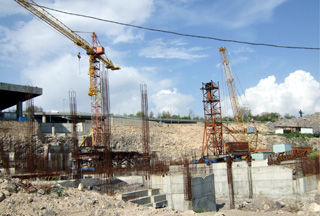
Who marred development indices in construction sector?

It is expected that the economic growth rate in Armenia will not exceed 4.2-4.3% in the end of the year.
After international organizations revised their estimation of Armenia’s growth rate in 2013, the government announced that the expected growth rate in the end of the year is 4.1%. Is this a failure? The problem is that the budget for 2013 is based on an expectation of 6.2% growth. This means the government’s forecast of economic growth did not come true. In relation to this statement the government’s Vache Gabrielyan said, “This does not mean the government has failed. Forecasts normally come true and sometimes do not come true to some extent. There have been changes of external factors such as increased rates for energetic resources, which have to be explained to the society and parliament.” Certainly forecasts may not come true but there is something that these people should worry about. In March, in a meeting with journalists president Serzh Sargsyan warned by saying, “A government of the Republic of Armenia that will not be able to provide 7% economic growth should resign.” Before this announcement the president said that he would not accept any explanations for failure.
Will the government resign? Ministers abide this topic and mostly discuss issues related to economy, Euro zone crisis, gas, etc.
The explanation that increased price of gas has affected the growth rate is not fair because even though it affects growth, one year ago they knew about the expected rate increase and should have taken this risk into consideration.
PA faction member Mikayel Melkumyan said in the parliament that there is decline in the sector of construction, which is one of the main reasons of slowing economic growth. According to official statistics, in January-September all sector of Armenia’s economy developed but the construction sector declined. The construction sector growth rate declined by 92,% compared to the previous year and amounted 244,9 million dram. To compare, the volume of construction sector financial investment in 2008 was 604.2 billion. In order to understand why the economic growth was hampered we should firstly understand why the construction sector declined. This is the question the MP asked the minister of city construction Samvel Tadevosyan. The minister said construction works are finished in the end of the year, thus they should wait till the end of the year to make final conclusion whether the construction sector has grown or no. “These rates that we see now will change, but still there is decline in the sector and the reason is the reduction of foreign borrowing inflow,” said the minister of city construction. The government wants to put the blame for low economic growth in the constructions sector on international organizations. First, let’s find out if international borrowing could really influence on the construction sector growth.
The letter of the National Statistical Service tells that the volume of construction works implemented on the account of foreign borrowing reduced by 33.5% to 15.8 billion drams. The volume of construction on the account of borrowings received from the World Bank have significantly reduced (by 41.8%, and the volume is 6.2 billion drams). The volume of construction works based on borrowings from international institutions was 6.5%. If the foreign borrowing volumes did not reduce, the volume of construction sector investments would stay the same (at around 23 billion drams). This is more by 7 billion. Still this would not be enough to compensate the 9.8% slump in construction sector. In a word, international borrowing has affected the construction sector but not to the extent of being decisive.
Most investment in construction sector is done by construction companies (45.3%). The volume of their investment in construction reduced by 17.2%. This slump affected the construction rate most. Some construction is done by community and public budgets as well (both together in total make 17.5%). Investment in construction from the public budget reduced by 11.7%, and from community budgets – by 13.1%. However, people have made more investment in private construction in properties by 19.4%, and the volume of such investments is 69.2 billion drams. This means that the slump would be even more if Armenians were not fond of construction.
The analysis above shows that the government should not put the blame for slump in the construction sector on international institutions.
By Babken Tunyan























